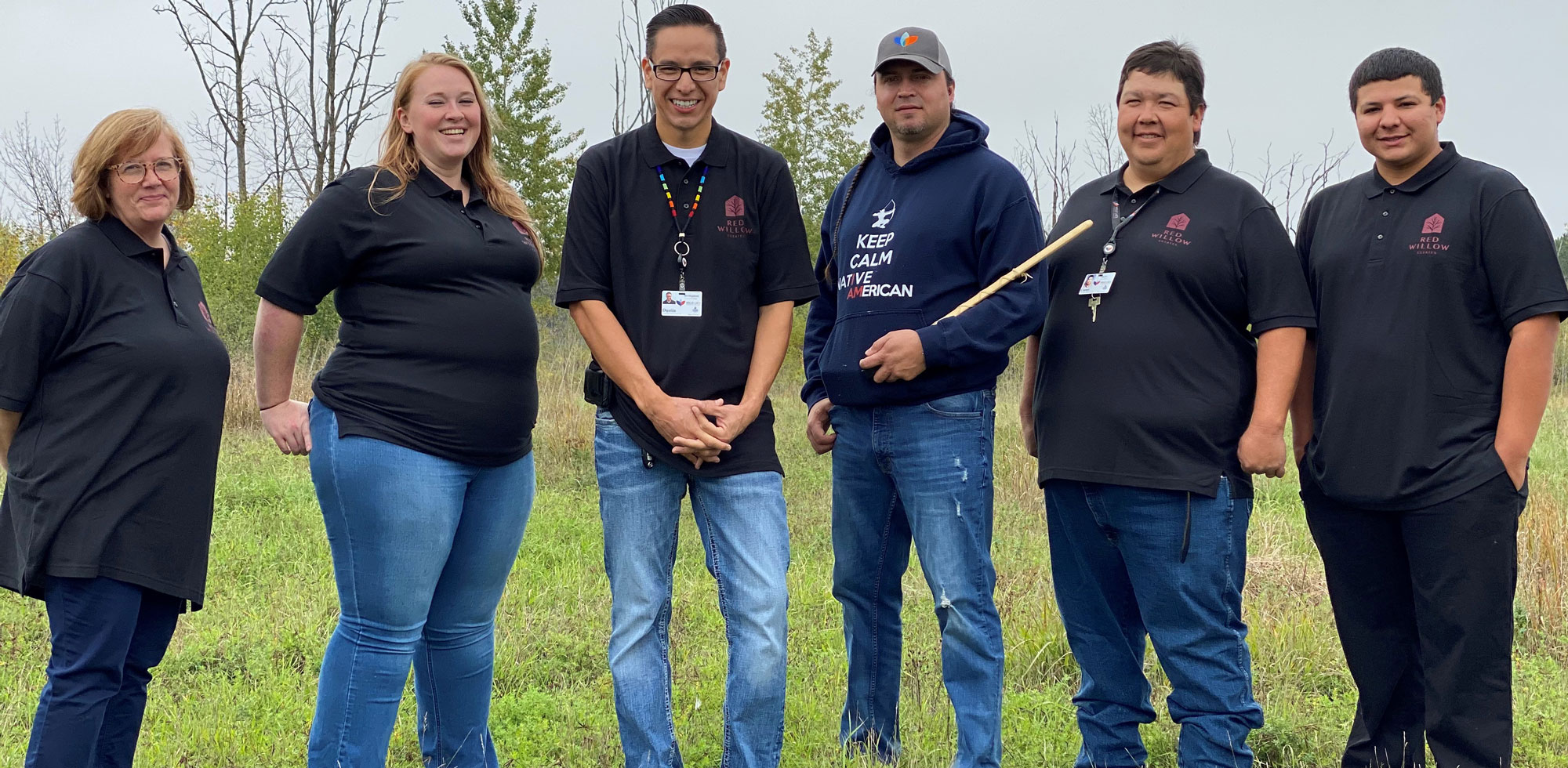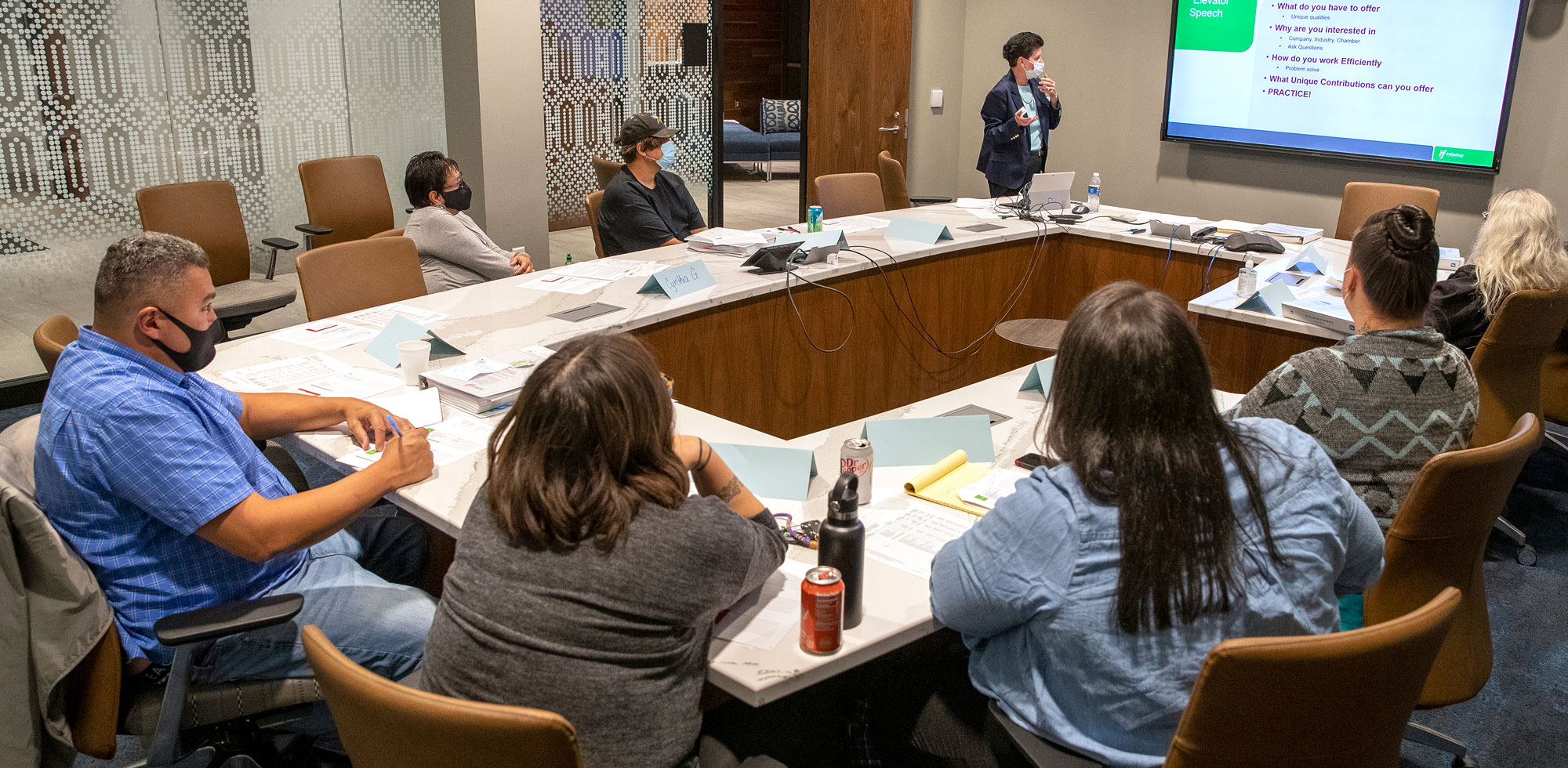
Planting the Seeds
How Mille Lacs Corporate Ventures is building a homegrown economy for their region
By Elizabeth Foy Larsen | Photography by John Linn
The Mille Lacs Band of Ojibwe’s two casinos have been wildly successful since opening in the early 1990s. Bolstered by casino-generated revenue, tribal living standards have been on the rise as the Band’s business entity, Mille Lacs Corporate Ventures (MLCV), works to diversify the tribal economy beyond gaming.
“The company and the tribe had come to a realization that gaming was never supposed to be the answer,” said Joseph Nayquonabe Jr., who grew up on the Mille Lacs Reservation and worked his way up from a college internship at MLCV to become its CEO. He also sits on the Initiative Foundation’s Board of Trustees. “It was supposed to be the bridge that would propel us into something that was more self-sufficient.”
Founded in the late 1980s and headquartered in Onamia, MLCV was created as a political subdivision and tribal corporation to manage the Band’s business affairs. Its holdings include Grand Casino Mille Lacs, Grand Casino Hinckley, a host of hospitality businesses, including hotels, restaurants and resorts, a commercial laundry, cinema, grocery store, gas/convenience stores, and a golf course.
Nayquonabe and his colleagues have talked for several years about investing in initiatives that support entrepreneurs. The conversation turned urgent in early 2020 when the COVID-19 pandemic closed the casinos for 77 days.
“Our casinos recruit a large volume of visitors to the area that make the economics of our rural region work,” said Dustin Goslin, MLCV’s vice president of business and economic development. “It was scary for all of us because we [wondered] what would happen if the casinos were no longer the economic engine.”
Those fraught days and months spurred MLCV to step up its prioritization of other opportunities: support for entrepreneurs; expanded access to child care; workforce housing; and increased access to internet broadband.
To explore greater economic potential within the wider Mille Lacs Tribal Economy, the Band hired Northspan, a Duluth-based economic development consultancy, to explore the development of a new entrepreneurial ecosystem.
“We were the first tribe in the country to be fortunate enough to ride the gaming wave,” said Nayquonabe. “So, in some ways, we are the future of what other regions are going to be seeing. Eventually, [gaming] doesn’t continue to grow. We have to innovate in all lanes of business.” And the arc of innovation means investing in a host of initiatives that, when taken together, create a more holistic solution for economic opportunity.

A Place to Call Home
The gaming business has provided insight into the role that affordable workforce housing plays in a healthy economy. The reality: More than 70 percent of the Mille Lacs Tribal Economy workforce lives outside the community and 60 percent commute up to 50 miles each day.
To make the case that quality, affordable workforce housing is good for local businesses and families, MLCV drew upon past experience and old-fashioned storytelling. Their first project, Lady Luck Estates in Hinckley, was met with pockets of resistance. Despite the initial pushback, Lady Luck Estates opened to great success. More than 165 applications have been received since the development opened in 2018, and all 28 townhomes are occupied.
“When we went in front of the Onamia City Council to propose our newest project [Red Willow Estates], everyone was excited and ready to roll,” Goslin said. By humanizing affordable housing and drawing on the real-life stories of Lady Luck Estates residents—including a school teacher, a baker, a hair stylist and tribal and non-tribal families alike—opposition seemed to melt away.
Last fall, MLCV held an Ojibwe blessing at the future site of Red Willow Estates. It will have 30 townhomes outfitted with attached garages and energy-efficient appliances. In addition, it will include a connection to the Soo Line recreation trail, Ojibwe-inspired landscaping themes, a community garden, a basketball court, a playground, and an outdoor community gathering area with grills, picnic tables and a covered shelter. Additional affordable housing projects are being considered across the region.
Bringing Broadband
Internet access has become another necessary utility, like water and electricity. Prior to the pandemic, MLCV wasn’t sure it had a role in bringing broadband to tribal economy communities. As stay-at-home measures went into place—as workers went remote and children across the region started going to school from their bedrooms—the lack of quality broadband coverage became evident. Gaps in service were especially evident for Band members who live in what’s known as the last mile, or the final leg of a telecommunication network, where connections are spotty and service is expensive. Mille Lacs County ranks 69th out of Minnesota’s 87 counties in internet connectivity. Neighboring Kanabec County is 87th.
“We quickly found out that broadband affected us very deeply,” said Beth Gruber, MLCV’s director of planning and community engagement and the point person for their broadband initiatives. So MLCV started asking the broadband community how other tribes were getting their internet needs met. The answers were disheartening.
“We were told that tribes aren’t ready for broadband,” said Goslin. “That they’re not at the table, they don’t have plans.”
MLCV knew the naysayers were wrong, so they set out to find new solutions. A trustee of the Grand Rapids-based Blandin Foundation, Goslin knew about the nonprofit’s work connecting Greater Minnesota with broadband resources. At his prompting, MLCV embarked on a 15-week Blandin program to educate a cohort of community members—educators and government officials from across the Mille Lacs Tribal Economy, including Pine, Kanabec and Aitkin counties— about broadband opportunities.
With new knowledge and insights gained, MLCV set to work researching providers, including Starlink, the satellite internet service owned by Elon Musk’s SpaceX. An Initiative Foundation grant helped to support research on SpaceX technology in rural places. The Band ultimately decided to partner with Brainerd-based telecommunications company CTC to build and own their network. Several capital recruitment rounds have been completed, including an $11.3 million financing proposal to the National Tribal Broadband Grant program. The next step is to complete a feasibility study to understand service gaps.

Elevating Entrepreneurs
When plotting its business diversification strategy, MLCV understood the role entrepreneurs play in starting locally owned small businesses. Although entrepreneurism stretches back generations in tribal communities, MLCV wasn’t sure there would be enough community interest in a program that supports the needs of start-up businesses. To help get their efforts off the ground, MLCV partnered with the Initiative Foundation and its Enterprise Academy, the heart of which is a 12-week course in basic business principles and business plan development.
Since 2020, MLCV has completed three cohorts with 30 graduates. A fourth cohort began in February. Graduates have completed business plans for a range of endeavors, including natural teas, a luxury car-detailing service, an online bead crafting supply store, and supporting efforts for a new Rosetta Stone course that teaches the Ojibwe language. Through the Initiative Foundation program, graduates receive ongoing support, and those with viable business plans are eligible for microlending.
Some of these graduates will eventually bring their businesses to one of MLCV’s future incubator spaces, offering physical space and financial resources to businesses that support the tribal economy. The entrepreneurial project earned the 2021 Excellence in Economic Development Award from the Economic Development Association of Minnesota (EDAM).
“MLCV’s genuine passion for building homegrown economies by investing in people is so critical,” said Brian Voerding, Initiative Foundation’s vice president for inclusive entrepreneurship. “Investing in people sometimes takes decades and generations to really pay off. It takes a really big vision and a really big commitment to make that investment, to stick to it and commit to it.”
The entrepreneurship initiative has been such a success that MLCV envisions growing its reach. “We want to engage with all aspiring entrepreneurs in the tribal economy and be very holistic and inclusive of everybody who lives here,” said Gruber. “As a business leader in the community, we also want to inspire the youth to be future business leaders, so one of the big things we’ll work on over the next year is how we can get a youth program started.”
It’s all part of a comprehensive and innovative approach to economic and community development. “We want to look forward seven generations and know that we helped start all of these new things that helped diversify the economy,” said Goslin.
“We want to take all these cool things we’ve learned about launching this industry in the past 30 years and pivot and do the same thing in other areas so that we can continue to improve the trajectory of where quality of life’s heading for people in the tribal economy,” Nayquonabe said. “Before Indian gaming, tribal people suffered from poverty and low employment. That’s turned around dramatically in the last 30 years, and we don’t want that to stop for tribal and non-tribal people living in the Mille Lacs Tribal Economy.”